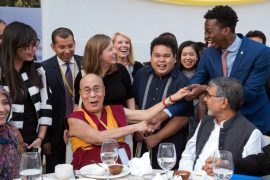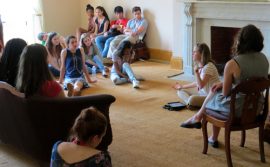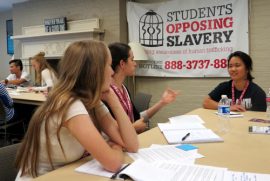Slavery. It’s an issue that still exists today. In 2012, four teens founded Students Opposing Slavery at President Lincoln’s Cottage — the site where Lincoln spent one quarter of his presidency as he led the country through the Civil War and the consequences of the 1863 Emancipation Proclamation.
June 2017 marks the 5th International Summit of Students Opposing Slavery, which has won awards for its power and importance in raising awareness about modern slavery — including the EdCom Award for Excellence in Programming from the American Alliance of Museums, and the Leadership in History Award of Merit from the American Association for State and Local History.
And, in October 2016, SOS received the Presidential Award for Extraordinary Efforts to Combat Trafficking in Persons at the White House meeting of the President’s Interagency Task Force to monitor and combat this issue.
 President Lincoln’s Cottage CEO and Executive Director Erin Carlson Mast (pictured right) explains:
President Lincoln’s Cottage CEO and Executive Director Erin Carlson Mast (pictured right) explains:
“The SOS participants are committed to ending slavery in their lifetime. Through the Students Opposing Slavery International Summit,” Mast insists.
“We bring dozens of youth from around the world to President Lincoln’s Cottage to gain knowledge and training, which they use to continue the fight for freedom in their communities.
 President Lincoln’s Cottage Associate Director for Programs Callie Hawkins, who organizes the Summit, adds:
President Lincoln’s Cottage Associate Director for Programs Callie Hawkins, who organizes the Summit, adds:
“Thanks to the Summit’s presentations, workshops, and reflection exercises presented by experts in the anti-trafficking field, students in the SOS network have emerged as leaders and have become trusted voices on the issue internationally. They have started NGOs; published articles; participated in stakeholder meetings with federal agencies; and organized assemblies, concerts, fundraisers, and school-wide art shows to raise the awareness of this problem.”
Click here to watch our video interview with Mast, Hawkins, and a student who has attended two SOS Summits.
Scroll down to read more about this fascinating conference that empowers high school students to help eradicate slavery.
To get involved, click here to apply to participate in the June 2017 Summit, which empowers high school students to help eradicate slavery: lincolncottage.org/education/sos
Questions? Send an email to [email protected].
Hope Katz Gibbs: We are thankful to be here today at President Lincoln’s Cottage to talk about the upcoming 2017 Students Opposing Slavery Summit with Erin Carlson Mast, Callie Hawkins, and high school student Cameron Gadson, who has attended the annual Summit twice. Erin, when four teens came to you with the idea to start SOS, what did you think?
 Erin Carlson Mast: We thought it was a perfect fit for us. Part of our mission is to continue Lincoln’s fight for freedom and give people the history and resources they need to take up Lincoln’s unfinished work. We were encouraged by many to create a “youth Lincoln Leadership program,” but that never seemed quite right to us. We didn’t want to create a roomful of Lincolns — part of Lincoln’s success in tackling slavery was having a network of people doing different things, thinking differently about a common problem.
Erin Carlson Mast: We thought it was a perfect fit for us. Part of our mission is to continue Lincoln’s fight for freedom and give people the history and resources they need to take up Lincoln’s unfinished work. We were encouraged by many to create a “youth Lincoln Leadership program,” but that never seemed quite right to us. We didn’t want to create a roomful of Lincolns — part of Lincoln’s success in tackling slavery was having a network of people doing different things, thinking differently about a common problem.
What did you do to get the first international Summit up and running?
Callie Hawkins: We had been working with four local high school students for some time on the best way to engage their peers. They had had some success raising awareness about modern slavery through student assembly presentations at their schools, but we wanted to find ways to engage youth on a deeper level.
Then, we had an opportunity to travel to Thailand to see how youth in Southeast Asia were involved and tackling this issue. That gave us a blueprint of what was possible. We relied heavily on our existing relationships with federal agencies and nonprofits that provide services to victims and survivors to develop a week-long program with immersive workshops, content sessions, and time to build the students’ relationships with one another to ensure a strong network.
Hope Katz Gibbs: Cameron, you have participated in two Summits so far. How did you learn about them?
 Cameron Gadson: It was my mother who recommended the SOS program to me when I was a freshman. She thought I’d really enjoy it, and she was right. After the one-week program ended, I was totally shaken up by all the information I learned. Since then I’ve tried to carry that information to my classmates, to my friends outside of my school, and even to my family.
Cameron Gadson: It was my mother who recommended the SOS program to me when I was a freshman. She thought I’d really enjoy it, and she was right. After the one-week program ended, I was totally shaken up by all the information I learned. Since then I’ve tried to carry that information to my classmates, to my friends outside of my school, and even to my family.
Hope Katz Gibbs: Callie, tell us more about what students learn during the Summit.
Callie Hawkins: First and foremost, they learn the history of President Lincoln’s Cottage and the work Lincoln did here to end slavery in his time. The SOS content sessions are developed to give students a deeper look at modern slavery in the United States and around the world — who is affected by it, where it exists, and age-appropriate ways they can help end it. SOS doesn’t end with the Summit — our work with the students is year-round — but it’s an essential experience for training and building a cohesive network. They build trust, they build skills, they build understanding.
Hope Katz Gibbs: Erin, as the CEO and executive director of President Lincoln’s Cottage, tell us what your goals are for the Summit in the coming years.
 Erin Carlson Mast: A key goal is that through this Summit, with these youth abolitionists, we’re planting the seeds of emancipation across the world. That’s a key goal — to make this network stronger and more global with each passing year, and to find better ways to support them as they go off to college and chart their careers. That’s what we’re looking at next, SOS College. We already have alumni of SOS involved at the college level — some have served as mentors at the SOS Summit. There is a need to grow the network beyond high school, and our goal is to answer that need.
Erin Carlson Mast: A key goal is that through this Summit, with these youth abolitionists, we’re planting the seeds of emancipation across the world. That’s a key goal — to make this network stronger and more global with each passing year, and to find better ways to support them as they go off to college and chart their careers. That’s what we’re looking at next, SOS College. We already have alumni of SOS involved at the college level — some have served as mentors at the SOS Summit. There is a need to grow the network beyond high school, and our goal is to answer that need.
Hope Katz Gibbs: Callie, how can more students get involved in the Summit?
 Callie Hawkins: Programs like this require a great deal of support. For every student who comes, there are travel expenses — visas, flights, trains — in addition to needs while they’re here. We have generous donors who sponsor every student who gets involved, but we could always use more support.
Callie Hawkins: Programs like this require a great deal of support. For every student who comes, there are travel expenses — visas, flights, trains — in addition to needs while they’re here. We have generous donors who sponsor every student who gets involved, but we could always use more support.
Thank you for watching GratefulAmericanTV.com — the video channel of David Bruce Smith’s GratefulAmericanFoundation.com, and GratefulAmericanKids.com. We look forward to coming back to President Lincoln’s Cottage in June to attend the 2017 Students Opposing Slavery Summit, and bringing you a documentary about the important work that teenagers are doing to raise awareness about modern slavery. Stay tuned!
For more information on President Lincoln’s Cottage Students Opposing Slavery and the SOS International Summit, visit www.lincolncottage.org, or send an email to [email protected].
